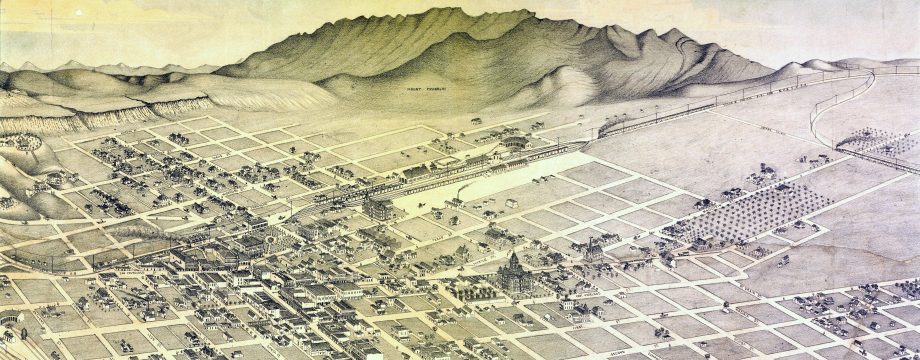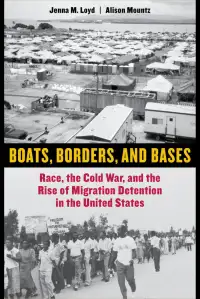By Nicholas Piraino, Stony Brook University.
A graduate student in the Department of History, Nicholas studies 20th Century U.S. history, U.S. politics, race, and labor.
Review of Boats, Borders, and Bases: Race, the Cold War, and the Rise of Migration Detention in the United States, by Jenna M. Loyd & Alison Mountz,University of California Press, 2018.
Boats, Borders, and Bases is an ambitious book that blends together several fields such as geography, sociology, immigration studies, and history. In doing so it reveals new facets of the discussion on U.S. immigration laws, outlining government programs and political schemes which completely challenge the common understanding of immigration into the United States. However, at certain points this blending of fields feels a little too ambitious. While the research involved in Boats, Borders, and Bases is exhaustive and seems extremely sound, at times it feels as if the methodologies used by the authors are not utilized to their full potentials. This may be because of the sheer variety of perspectives the authors use, such as a historical perspective, despite specializing in geography.
Loyd and Mountz explore the topics of immigration and the carceral state in the U.S. through the scope of Cold War era migration. They focus specifically on Caribbean migration during the 1970s and 80s in comparison to migration at the U.S.-Mexico border, showing that the U.S. Government created a system of racialized control and detention of Caribbean migrants which formed the basis of almost all modern immigration policy in the United States. They challenge the narrative put forth by the U.S. government and argue that official policy is to draw public attention to certain parts of the border and the immigration process. This hides what the government is doing elsewhere, as the public is not paying attention to what is happening in plain sight. For example, if one were to speak to another citizen about immigration the conversation would almost inevitably turn to the U.S.-Mexico border, never touching upon Caribbean migrants.
This revelation completely changes how we should be discussing U.S. immigration, and by definition calls for accessibility above all else. While scholarly discussion and debate over these conclusions is vital, spreading this knowledge among the wider public is even more important. After all, if unsavory activities are being performed by the Government based on the ignorance of the common people then the best way to police such behavior is to spread public awareness. Therefore, it is frustrating to read Boats, Borders, and Bases while attempting to interpret its heavy use of technical jargon.
Loyd and Mountz seem quite fond of not only using highly specialized terms that only experts would recognize, but also using unnecessarily complicated language. In addition, when they quote legalese drenched passages from sources such as the Department of Homeland Security, for example, they rarely if ever interpret that information in plain language for their readers. While those who pursue higher education can at least work out what they are saying with a modicum of effort, the average person would be completely lost trying to understand their argument. While this writing style is not necessarily a bad thing, it does not lend itself to a topic which by its very nature calls for maximum accessibility. Rather, such practices smack of academic gatekeeping.
I am truly inspired by the research Loyd and Mountz have done and enjoyed reading about their findings. However, I can not shake the feeling that that they have not done proper justice to this extremely important topic, possibly due to a lack of background in the fields and methodologies they attempt to frame their argument with. For example, their historical perspective. Boats, Borders, and Bases is clearly written as a historical work. Loyd and Mountz frame their argument chronologically and thematically, connecting their argument to the larger historical context of immigration. They make heavy use of archives and draw on the works of noted historians such as Foucault to support their thesis. However, they do not look at other sources of information such as oral histories. Their book lacks the perspectives of the migrants they espouse, even as they argue that certain government policies were put in place to terrorize immigrants. In addition, they often make references to ideas put forth by past historians but do not explain them in their own words. They simply make a footnote directing readers to the works of other scholars, essentially giving out homework.
Again, I do find Boats, Borders, and Bases a fascinating read. I also believe it is an important addition to the historiography of borderland studies, and the national discussion on immigration. A discussion that is becoming increasingly heated and important with every year. I do not intend for my criticism to be taken as an all-out attack on the work of Loyd and Mountz. Rather, I simply wish to offer my perspective as someone who is still in the early stages of their professional scholastic career. Sometimes it is hard to remember the perspective of the layman when an author passed beyond that point years ago. However, it is always important to keep accessibility in mind when writing. After all, our work as scholars does little good if it can only be accessed and understood by our relatively small community.

